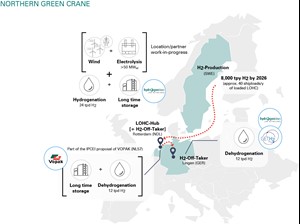News
Northern Green Crane to provide industrial-scale green H2 import from Sweden by 2026
Green Crane stands as a beacon for ramping-up a pan-European H2 transport infrastructure, to be enabled by the liquid organic H2 carrier (LOHC) technology. By establishing green H2 production in Sweden, the project is renamed to Northern Green Crane. The access to the source in Sweden significantly improves the former Green Crane project, and all landing points remain as planned by Hydrogenious LOHC Technologies with its industry partners Royal Vopak and the Get H2 initiative in Germany.
Northern Green Crane will become one of the first industrial-scale green H2 import projects for Germany and the Netherlands, needed to increase Europe’s energy security and to contribute to the ambitious plans of the European Commission. With its strong European genes, Northern Green Crane and its partners are applying for the ‘Important Projects of Common European Interest’ (IPCEIs) funding scheme. All project applications have been submitted within the RHATL wave (regional hubs and their links) to the European Commission for approval.
Backed by a strong consortium and with its unique LOHC technology, which serves as an efficient vector for the storage and transport of H2, Northern Green Crane will be one of the first projects to import green H2 at industrial scale to the Netherlands and Germany by 2026. By using existing liquid fuel infrastructure, the project enables the acceleration of import activities, providing up to 8,000 tpy of green H2. It will lay strong steppingstones for future large-scale imports via LOHC, accessing low-cost green H2 sources as well as providing crucial conditions for the decarbonization of industry and mobility.
With green H2 production in Sweden the project accesses new green H2 sources and strengthens the landing locations in Germany and the Netherlands. Sweden as a producing country is characterized by its great renewable energy potential including hydro and wind power, as well as excellent corresponding infrastructure and industry players. The chosen country fulfils all the regulatory prerequisites for green H2.
Furthermore, with this setup, the project should meet all requirements proposed by the IPCEI framework, such as involving several EU countries and generating positive spillover effects across the EU. Additionally, the project has the potential to decarbonize local heat supply by injecting the excess heat of the hydrogenation plant into a heating grid. This sector coupling will create further positive climate effects. The project will be realized by storing green H2 in LOHC (carrier material benzyl toluene) in Sweden with a 24-tpd-H2 hydrogenation plant from Hydrogenious LOHC Technologies. Via approximately 40 shiploads per year, the LOHC loaded with hydrogen will be transported from Sweden to the Netherlands.
In Rotterdam, half of the hydrogen will be released in a newly 12-tpd-H2 Hydrogenious LOHC’ dehydrogenation plant, to reach industry in the port and hinterland region. The other half of the hydrogen-loaded LOHC will be transported by barge via the river Ems to Lingen/Germany. There, the hydrogen will be released from the LOHC in another 12-tpd-H2 Hydrogenious LOHC’ dehydrogenation plant and used by local industry as well as fed into a H2 pipeline as part of the GET H2 initiative.
The project provides a unique H2 network connecting low-cost green H2 sources and industry demand across Europe, accelerating import activities, and supporting Europe’s ambitious decarbonization goals.


